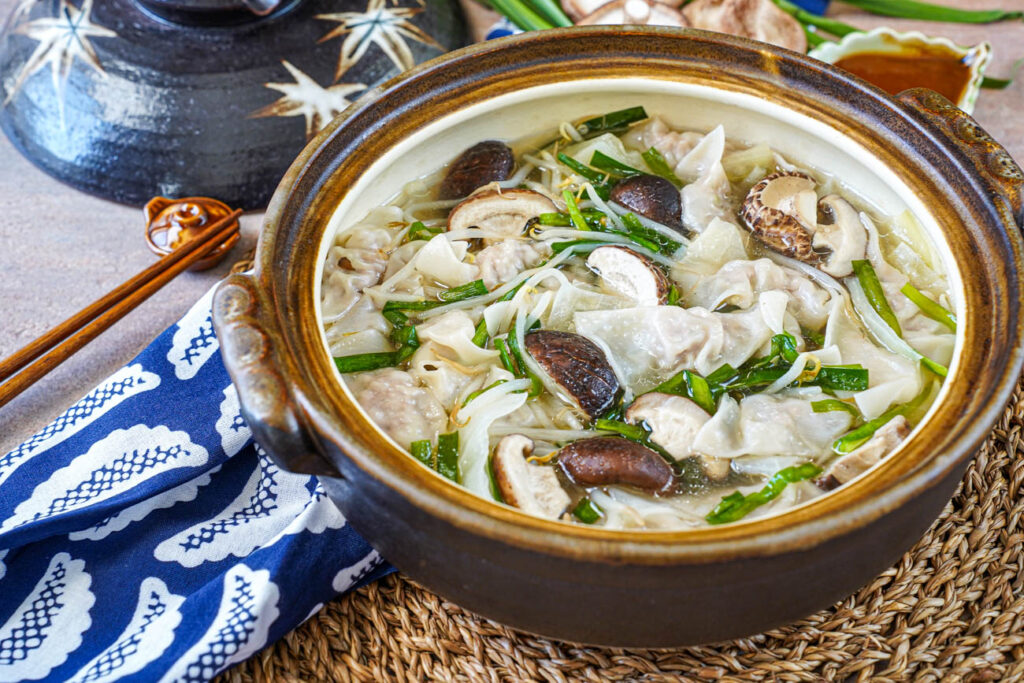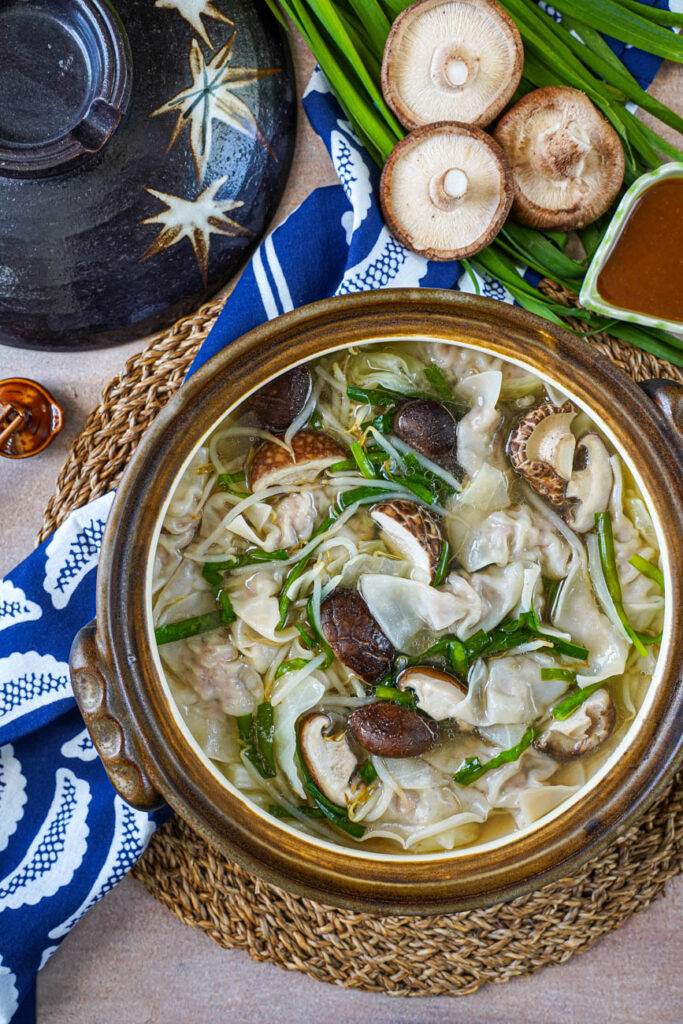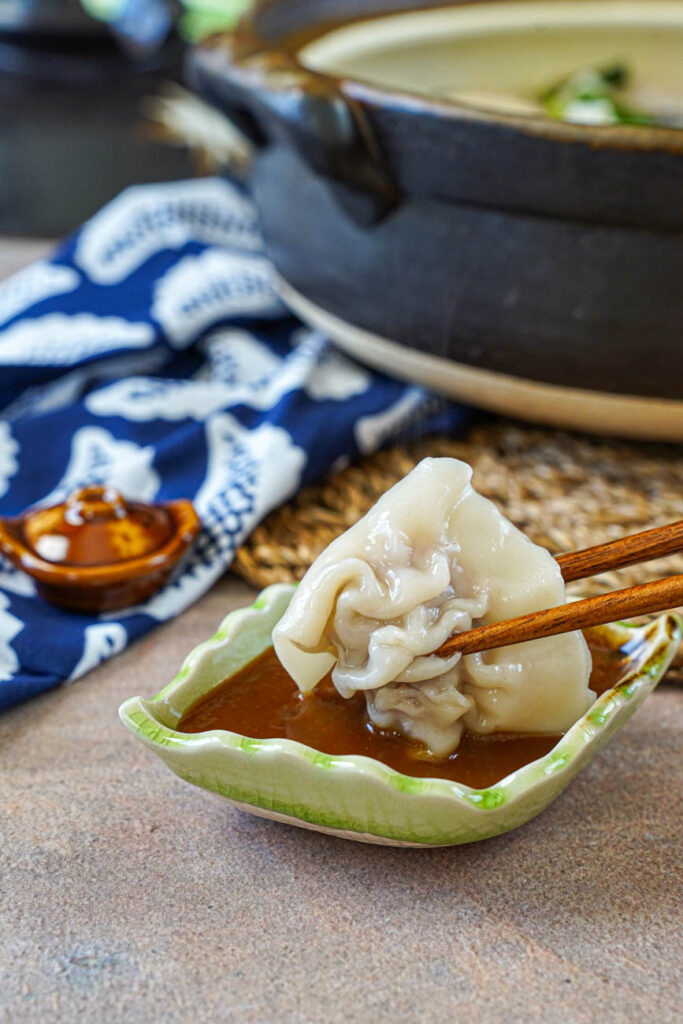Donabe: Classic and Modern Japanese Clay Pot Cooking, written by Naoko Takei Moore and Kyle Connaughton, showcases six styles of the Donabe with a variety of authentic and more unique recipes. A few highlights include Kyoto-Style Saikyo Miso Hot Pot (Saikyo Nabe), Taro Rice (Sato-Imo Gohan), Green Tea Rice Balls (Matcha Onigiri), Salmon Chowder with Miso Soy-Milk Broth, and Smoked Chicken Tender Salad with Kurozu Vinaigrette. I will also be sharing their recipe for Gyoza Nabe (Japanese Dumpling Hot Pot) following the review.
Disclosure: I received this book from Blogging for Books in exchange for my honest review. All comments and opinions are my own.

Naoko Takei Moore and Kyle Connaughton
Naoko Takei Moore grew up in Tokyo, Japan and moved to L.A. in 2001 to study at Le Cordon Bleu in Pasadena.
During a trip back to Japan, she discovered the double-lid donabe used for making rice. Naoko contacted the company that made the donabe, Nagatani-en, and began distribution to the United States. She now has an online donabe shop and hosts donabe cooking classes in her home.
Kyle Connaughton’s culinary career has taken him to L.A., Hokkaido, England, and back to California.
He was the head chief of research and development for The Fat Duck, a three-star Michelin restaurant. He recently opened Single Thread Farms Restaurant & Inn with his wife in Healdsburg, California.
Donabe
The Donabe is a traditional earthen cookware often used in the winter for simmering one-pot meals. It is made of porous clay for higher heat retention and the interior glaze helps with natural infrared radiant heating.
In Donabe, everything about this clay pot is explained from the history and culture surrounding the pot to choosing one plus a seasoning guide, cooking safety, and life-long care. Background information on Iga, the home of the donabe, and the company Nagatani-en is also provided.
Chapters are divided based on cooking style: Classic-Style Donabe; Double-Lid Donabe Rice Cooker; Donabe for Soup and Stew; Donabe Steamer; Tagine-Style Donabe; Donabe Smoker; and Dashi, Sauces, and Condiments. A different type of donabe is covered in each chapter. If you only have the classic-style, substitutions are given for what other cookware to use.
The striking photography is by Eric Wolfinger. Every recipe includes at least one beautifully styled full page photo, generally of the finished dish. There are also photos of various meal and menu ideas, the making of the donabe, and the occasional collection of step-by-step photos.
Headnotes at the beginning of every recipe include information about the dish and tips for success. Measurements are provided in US customary and metric. The name of the recipe is also listed in Japanese romaji when applicable. Required special equipment is labeled at the top of the page along with shime (finishing course) suggestions and variations.
Gyoza Nabe (Japanese Dumpling Hot Pot)

To pair with the review, I made Gyoza Nabe (餃子鍋, Japanese Dumpling Hot Pot)! Pork-filled gyoza are simmered in a kombu dashi with cabbage, shiitake mushrooms, beansprouts, and garlic chives.
To finish, the dumplings are served with an easy-to-prepare Miso-Vinegar Dipping Sauce. Overall, it is such a comforting meal and especially perfect for cooler weather.
A Few Gyoza Nabe Notes
To avoid overcooking the gyoza, simmer in batches along with the shiitake mushrooms, bean sprouts, and garlic chives.
The dumplings come together with a seasoned pork filling. If avoiding pork, swap for your favorite beef or vegetarian filling. If store-bought gyoza wrappers are unavailable, you can use a homemade gyoza dough.
To form the gyoza, you can simply fold the dumplings in half or form pleats. Whenever I make gyoza and other dumplings, I generally double the batch and freeze the extra for easy meals later.
To freeze, arrange the extra dumplings in a single layer on a parchment lined baking sheet and place in the freezer. Once frozen, gently transfer to a freezer safe bag. You can cook the gyoza straight from the freezer, but may need to add a couple of minutes to the simmering time.
The Miso-Vinegar Dipping Sauce lasts 7-10 days in an airtight container in the refrigerator. It is best paired with this Gyoza Nabe, shabu-shabu, and steamed vegetables.
The shime (finishing course) suggestion for this recipe states to lightly season the broth with soy sauce or fish sauce and mirin. Add some cooked rice noodles and chopped green onion for a light soup.
Notable Ingredients

To make the kombu dashi, add 5 cups of water to the donabe and 2 (3×6 inch/7.5×15 centimeter) pieces of kombu. Allow to sit for 30 minutes.
Place over medium heat and remove the kombu right before it comes to a simmer, about 15 minutes. Remove from heat until ready to use for the Gyoza Nabe.
You can also make the dashi via cold infusion: allow to soak in a bowl or pitcher covered for 18-24 hours in the refrigerator. Remove the kombu before using the broth in the hot pot. Another option is to use Kombu Dashi powder.
Katakuriko (potato starch) is available in larger grocery stores in the gluten free or specialty flour sections and Asian food markets.
Garlic Chives (Gau Choi, Buchu, Nira, Chinese Chives) are an Asian variety of chives with a light onion and garlic flavor. The leaves are larger and more flat and have delicate white flowers. I often grow a few plants from seeds, but they are also available in the produce section of Asian markets and some large grocery stores. They are usually sold in big bundles. Be careful when growing them as they easily spread. There are also yellow and flowering hollow varieties.
Other Dishes

I also made Orange Butter Rice, Tori Soboro Gohan (Soy-Flavored Simmered Ground Chicken over Rice), Japanese-Style Sizzling Bibimbap, and Matcha Mushi Cake (Green Tea Steam Cake).
The Orange Butter Rice is an easy way to add a bit of extra flavor to white rice. Once the rice has been cooked, it is seasoned with usukuchi shoyu (light-colored soy sauce), butter, and orange zest. Naoko recommends pairing it with the Smoked Duck Breast with Creamy Wasabi-Green Onion Dipping Sauce.
I used the Classic Donabe to make the Tori Soboro Gohan. Ground chicken is simmered with sake, soy sauce, mirin, sugar, and ginger. It is served over plain white rice with soft boiled eggs.
I was immediately drawn to the recipe for Japanese-Style Sizzling Bibimbap. Sesame oil is heated in the donabe (I do not have a tagine-style donabe, so I used a deep cast iron pan) and the rice is added, then covered with the prepared vegetables. Once a crispy bottom forms on the rice, everything is tossed together, seasoned, and topped with marinated egg yolks.
Since I do not have a Mushi Nabe, I used a bamboo steamer set over a wok to make the Green Tea Steam Cake. This was my first time ever steaming a cake. It was so easy! I also do not have a nagashi-kan (Japanese metal mold with removable inner tray that fits inside the steamer), so I had to improvise a bit and divided the batter among three large muffin cups.

Donabe is a great pick for those interested in a variety of options for their clay pot. It is best for those who have a donabe or are interested in getting one. Recipes range from traditional to unique, easy to more complicated. There is a varied assortment of condiments, seafood, salads, poultry, meat, vegetables, desserts (steamed cake), appetizers, tofu, and rice.
Access to a market specializing in Japanese products is also helpful for many of the ingredients needed. Substituting an ingredient that you can’t find or for something you would prefer is also encouraged (i.e. using chives instead of mitsuba or swapping different leaf vegetables).
Gyoza Nabe (Japanese Dumpling Hot Pot) Recipe
Excerpt from Donabe
Gyoza Nabe (Japanese Dumpling Hot Pot)
Ingredients
- 14 ounces (400 grams) ground pork
- 1 tablespoon katakuriko potato starch
- 1 1/2 teaspoons finely grated peeled fresh ginger
- 1 tablespoon (15 milliliters) sake
- 2 tablespoons minced green onion
- 1 teaspoon toasted sesame oil
- 1 teaspoon soy sauce
- 1/4 teaspoon freshly ground black pepper
- 25-30 gyoza wrappers about 3 1/2-inch/8.5 centimeter diameter
- 4 cups (1 liter) Kombu Dashi
- 1/2 cup (120 milliliters) sake
- 3-4 leaves green cabbage cut into large bite-size pieces
- 6 medium shiitake mushrooms trimmed and halved
- 5 ounces (150 grams) mung bean sprouts crisp white part only
- 3 ounces (100 grams) nira garlic chives, bottom ends trimmed, then cut into 3-inch (7.5 centimeter) pieces
Miso-Vinegar Dipping Sauce:
- 1/3 cup (80 milliliters) red miso
- 1 tablespoon (15 milliliters) Saikyo miso or other sweet white miso
- 2 tablespoons (30 milliliters) sake
- 2 tablespoons (30 milliliters) mirin
- 2 tablespoons (25 grams) raw brown sugar
- 2 tablespoons (30 milliliters) soy sauce
- 1/4 cup (60 milliliters) rice vinegar
- 1 clove garlic finely grated
- 1 teaspoon finely grated peeled fresh ginger
- 2 teaspoons tobanjan fermented chili bean paste, optional
Instructions
To make the gyoza:
- Combine the first eight ingredients for the gyoza in a medium bowl. Knead by hand until the filling is smooth and shiny.
- Cover with plastic wrap and let rest in the refrigerator for 30 minutes.
- To fill the gyoza, mound about 1 tablespoon of the filling in the center of a wrapper, and use water to wet the edges around half of the wrapper's edge.
- Fold the wrapper in half by lifting the dry-edged side. Pinch the edges tightly to seal and place the gyoza on the baking tray lined with parchment paper.
- Repeat the process with the remaining wrappers until the filling is gone.
- Cover the dumplings with a damp paper towel until ready to cook. You can make them about 30 to 60 minutes in advance; any longer and the bottom of the gyoza wrappers become soggy.
To make the Gyoza Nabe:
- Combine the dashi and sake in a donabe. Cover and bring to a simmer over medium-high heat.
- Add the cabbage and cook until slightly tender, 30 to 60 seconds.
- Add half the gyoza and half the shiitake; return to a simmer.
- Simmer for a couple of minutes, then add half the bean sprouts and half the nira. Cook for another minute or until everything is cooked through and then remove from heat.
- Serve with Miso-Vinegar Dipping Sauce. Once the gyoza have disappeared, refill and reheat with remaining gyoza, shiitake, beansprouts, and garlic chives.
To make the Miso-Vinegar Dipping Sauce:
- Whisk together all the Miso-Vinegar Dipping Sauce ingredients in a saucepan and set over medium-low heat. Bring to a gentle simmer and stir constantly with a wooden spatula for 2 to 3 minutes, or until the mixture is slightly thickened and shiny.
- Turn off the heat and let it cool down completely.



Sadia Malik
interesting cookbook, would love to experiment with the cooking pot but unfortunately only have an electric stove top. The recipe looks delicious.